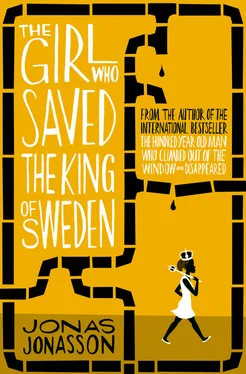‘We’ll call hydrogen-bearing gas A , and uranium hexafluoride can be B ,’ Nombeko said.
And she walked over to the blackboard on the wall, erased the engineer’s nonsense, and wrote the rate equation for an autocatalytic reaction of the first order.
When the engineer just stared blankly at the blackboard, she explained her reasoning by drawing a sigmoid curve.
When she had done that, she realized that Engineer van der Westhuizen understood no more of what she had written than any latrine emptier would have in the same situation. Or, for that matter, an assistant from the City of Johannesburg’s department of sanitation.
‘Please, Engineer,’ she said. ‘Try to understand. I have floors to scrub. The gas and the fluoride don’t get along and their unhappiness runs away with itself.’
‘What’s the solution?’ said the engineer.
‘I don’t know,’ said Nombeko. ‘I haven’t had time to think about it. Like I said, I’m the cleaning woman here.’
In that instant, one of Engineer van der Westhuizen’s many qualified colleagues came through the door. He had been sent by the research director to share some good news: the team had discovered that the problem was autocatalytic in nature; this resulted in chemical impurities in the filter of the processing machine, and they would soon be able to present a solution.
There was no reason for the colleague to say any of this, because just behind the Kaffir with the mop he saw what the engineer had written on his blackboard.
‘Oh, I see that you have already figured out what I came to tell you, boss. I won’t disturb you, then,’ said the colleague, and he turned round in the doorway.
Engineer van der Westhuizen sat behind his desk in silence and poured another tumbler full of Klipdrift.
Nombeko said that this certainly was lucky, wasn’t it? She would leave him alone in just a minute, but first she had a few questions. The first was whether the engineer thought it would be appropriate for her to deliver a mathematical explanation for how the team could increase the capacity from twelve thousand SWUs per year to twenty thousand, with a tail assay of 0.46 per cent.
The engineer did.
The other question was whether the engineer might be so kind as to order a new scrubbing brush for the office, since his dog had chewed the old one to pieces.
The engineer replied that he wasn’t making any promises, but he would see what he could do.
Nombeko thought she might as well appreciate the bright spots in her existence, as long as she was locked up with no possibility for escape. It would, for example, be exciting to see how long that sham of an engineer Westhuizen would last.
And all told, she did have it pretty good. She read her books, preferably while no one was looking; she mopped a few hallways and emptied a few ashtrays; and she read the research team’s analyses and explained them to the engineer as plainly as she could.
She spent her free time with the other help. They belonged to a minority that the regime of apartheid found more difficult to categorize; according to the rules they were ‘miscellaneous Asians’. More precisely, they were Chinese.
Chinese people as a race had ended up in South Africa almost a hundred years earlier, at a time when the country needed cheap labour (that also didn’t complain too bloody much) in the gold mines outside Johannesburg. That was history now, but Chinese colonies remained, and the language flourished.
The three Chinese girls (little sister, middle sister and big sister) were locked in with Nombeko at night. At first they were standoffish, but since mah-jongg is so much better with four than with three, it was worth a try, especially when the girl from Soweto didn’t seem to be as stupid as they had reason to believe, given that she wasn’t yellow.
Nombeko was happy to play, and she had soon learned almost everything about pong, kong and chow, as well as all possible winds in every imaginable direction. She had the advantage of being able to memorize all 144 of the tiles, so she won three out of four hands and let one of the girls win the fourth.
The Chinese girls and Nombeko also spent some time each week with the latter telling them all that had happened in the world since the last time, according to what she had been able to pick up here and there in the hallways and through the walls. On the one hand, it was not a comprehensive news report; on the other, the audience’s standards weren’t all that high. For example, when Nombeko reported that China had just decided that Aristotle and Shakespeare would no longer be forbidden in the country, the girls replied that this was sure to make both of them happy.
The sisters in misfortune became friends by way of the news reports and the game. And thanks to the characters and symbols on all of the tiles, the girls were inspired to teach Nombeko their Chinese dialect, upon which everyone had a good laugh at how quickly she learned and at the sisters’ less-successful attempts at the Xhosa Nombeko had learned from her mother.
From a historical perspective, the three Chinese girls’ morals were more dubious than Nombeko’s. They had ended up in the engineer’s possession in approximately the same way, but for fifteen years instead of seven. They had happened to meet the engineer at a bar in Johannesburg; he had made a pass at all three of them at the same time but was told that they needed money for a sick relative and wanted to sell . . . not their bodies, but rather a valuable family heirloom.
The engineer’s first priority was his horniness, but his second priority was the suspicion that he could make a killing, so he followed the girls home. There they showed him a patterned pottery goose from the Han dynasty, from approximately one hundred years before Christ. The girls wanted twenty thousand rand for the goose; the engineer realized that it must be worth at least ten times more, maybe a hundred! But the girls weren’t just girls – they were also Chinese, so he offered them fifteen thousand in cash outside the bank the next morning (‘Five thousand each, or nothing!’) and the idiots agreed to it.
The unique goose was given a place of honor on a pedestal in the engineer’s office until a year later when an Israeli Mossad agent, also a participant in the nuclear weapons project, took a closer look at the piece and declared it to be junk within ten seconds. The investigation that followed, led by an engineer with murder in his eyes, found that the goose had in fact been produced not by craftsmen in the province of Zhejiang during the Han dynasty approximately one hundred years before Christ, but rather by three young Chinese girls in a suburb of Johannesburg, during no dynasty at all, approximately one thousand, nine hundred and seventy five years after Christ.
But the girls had been careless enough to show him the goose in their own home. So the engineer and the legal system got hold of all three of them. Only two rand were left of the fifteen thousand, which was why the girls were now locked up at Pelindaba for at least ten more years. ‘Among ourselves, we call the engineer “鹅”,’ said one of the girls.
‘The goose,’ Nombeko translated.
What the Chinese girls wanted most of all was to return to the Chinese quarter of Johannesburg and continue producing geese from the time before Christ, but just do it a bit more elegantly than last time.
In the meantime, they had as little to complain about as Nombeko. Their work responsibilities were, among other things, to serve food to the engineer and the guards, as well as handle incoming and outgoing post. Especially the outgoing post. Everything, large and small, that could be stolen without being missed too much was quite simply addressed to the girls’ mother and placed in the out-box. Their mother received it all gratefully and sold it on, pleased with herself for once having made the investment of letting her girls learn to read and write in English.
Читать дальше












